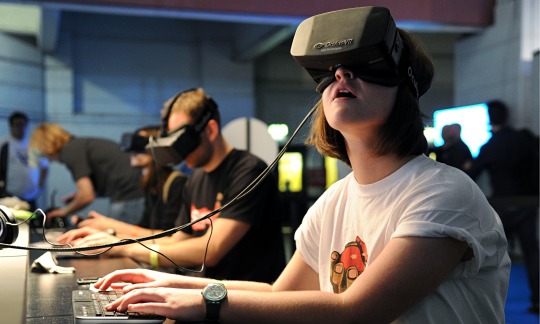Virtual Reality has been tipped to make great strides in the technology industry over the last few years. Big names like Samsung, HTC, Google and Facebook have attached themselves to the tech, and released some pretty powerful kit.

Image source: https://www.flickr.com/photos/bagogames/26104037025
Virtual reality was originally developed for the immersive experience in film, then leading to flight simulators (in the late 1920’s), through to the 1960’s when the first head mounted virtual reality display was developed. At this point though, it was designed to immerse the user into pictures and film with no interaction.
Skip forward a few decades, and we move into the 1990’s when games started to be developed for users’ immersion into the worlds being created (Sega and Nintendo being the leaders…) where interactivity was key. And who could forget The Matrix! A film where characters live in a fully simulated world, and a good number of them are completely unaware that they don’t live in the ‘real world’.
From a learning point of view there is plenty we can do with this type of technology, especially in the creative contexts that we specialise in at Falmouth.
Immersion into environments that are not yet created is a major win for the creative industries. For example, the architecture industry makes use of VR to navigate through spaces and buildings to demo spaces to clients, and walk through proposals throughout the design stages. There are even some companies who will take architectural plans and turn them into fully immersive virtual reality visualisations. They then provide their clients with Oculus Rift headsets and host walkthroughs of the plans. Have a look at the archdaily VR pages to see what’s happening in this area.
An interesting concept is VR art. Tiltbrush for the HTC Vive (interesting that it’s not an android app as it’s developed by Google) allows you to “paint in 3D virtual reality”, and they say that “Your room is your canvas. Your palette is your imagination. The possibilities are endless.” That all sounds a bit aspirational doesn’t it, but it would be interesting to hear an expert’s opinion if anyone has tried it or seen it used anywhere?
Another growing field in VR is fieldtrips. With the improvement in graphical representations of landscapes and detail virtual reality fieldtrips are becoming more popular in education. They serve to prepare a person for a trip, re-cap details of a trip, or even replace the trip and give users the ability to visit areas they would not usually have the chance to. Dr Naomi Holmes (Sheffield Hallam), Dr Scott Turner (Northampton) and I conducted a small scale research project a couple of years ago in this field.
Have a look at this video of TEDx talk “Designing for virtual reality and the impact on education | Alex Faaborg | TEDxCincinnati” (9:32) for some insight into a few of the challenges and benefits.